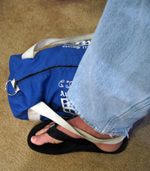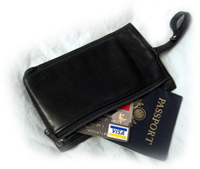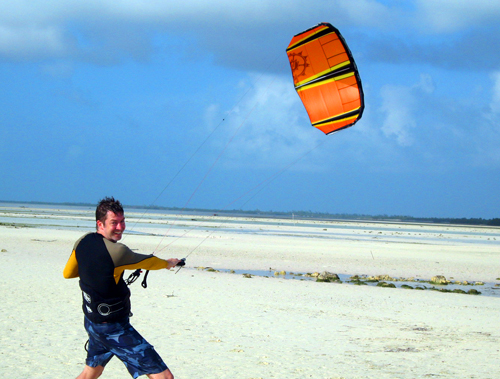1. Loop it or lose it – put your foot down
 When traveling alone you will at some point find yourself in a crowded airport terminal or restaurant waiting with multiple pieces of luggage. Professional thieves choose this high-commotion areas to target unsuspecting individuals because there are a lot of distractions and they can quietly snatch a bag while you are preoccupied with something else. When I’m at the gate and I know I’ve got my boarding pass and I’m good to go, I turn on the iPod and snooze before the flight. And under normal circumstances if I were to leave my bags on the ground next to me, I would become a prime target for a thief to stroll by and lift them. As simple as it sounds, here is a technique that prevents this:
When traveling alone you will at some point find yourself in a crowded airport terminal or restaurant waiting with multiple pieces of luggage. Professional thieves choose this high-commotion areas to target unsuspecting individuals because there are a lot of distractions and they can quietly snatch a bag while you are preoccupied with something else. When I’m at the gate and I know I’ve got my boarding pass and I’m good to go, I turn on the iPod and snooze before the flight. And under normal circumstances if I were to leave my bags on the ground next to me, I would become a prime target for a thief to stroll by and lift them. As simple as it sounds, here is a technique that prevents this:
Put your foot through the loop or strap. When I lived in Ecuador there was a great deal of bus travel involved and fellow exchange students had their backpacks snatched multiple times. This trick never failed me – in the best scenario it served as a deterrent for the observant bag snatcher and in the worst scenario it simple burglar alarm / leash that kept my bag on my person.
2. Improvise a bag handle
 Using plastic bags as carry-ons is just never a good idea if you can avoid it. Not only are they flimsy but they eventually turn your fingers into sausage links if they’re loaded with heavy stuff and you have to carry them far.
Using plastic bags as carry-ons is just never a good idea if you can avoid it. Not only are they flimsy but they eventually turn your fingers into sausage links if they’re loaded with heavy stuff and you have to carry them far.
If you have no other choice but the plastic bag as a carry-on, or even if your real luggage simply has a crappy handle, snag the cardboard tube from an empty toilet paper roll, cut it longitudinally and clip it over the bad handles. Obviously you can use other material to achieve the same purpose but I’ve found that the TP tube is a perfect solution and is guaranteed to be found anywhere you have a conventional toilet.
3. Ubiquitous travel doc accessibility
If you’re traveling internationally you should have your travel documents on you at all times. This is a no-brainer. I use a leather pouch with a belt loop that flips inside my pants. You should also store a copy of your passport and important docs in another location like your checked luggage while in transit or your hotel room while you’re there.
Another great tactic is to scan all your important credentials and then email them to yourself. Internet cafes are prevalent everywhere but the US so it works fairly well and you can get to your docs anywhere you can find Internet (use an encrypted zip file if you’re paranoid of storing them on gmail’s server). I came up with this idea last year– I happen to use gmail and emailed each scan to myself with the subject “vitaldoc: passport” etc. This allows me to pull up all my critical info by searching my gmail for “vitaldoc” anywhere I am that has Internet. I used this trick at the doctor’s office the other day using my treo’s web browser to get an insurance card I didn’t have in my wallet- very useful.
4. Protect your passwords on public Internet terminals
So how do you safely check email from public terminals while you’re traveling? This technique will not protect you from hardware-based keyloggers but it should defeat most software-based ones. Whatever you do, don’t type your password directly into the password field on a public terminal, rather put the characters you need (and then some) in the url bar and cut and paste your password together piecemeal from there. It’s debatable how effective this technique is as some keyloggers can store things like cursor position and clipboard elements. But, just like The Club (TM), if you make it tricky enough to determine yours over someone else’s, this should reduce the likelihood of someone jacking your credentials.
You can also put in a little time up front, bring a thumbdrive with the portable apps suite installed and setup secure POP to your email using the Thunderbird client (thanks Benny for that suggestion). At that point you also have the portable Firefox browser as well, so ideally with all your passwords stored in that instance you’re not entering them in the browser via the terminal. Just be sure to encrypt the thumbdrive, otherwise in the event you lose that, someone has direct access to all your accounts.
5. Free headphones for the in-flight movie
When the flight attendant strolls down the aisle peddling those $5 crappy plastic headphones that have been worn by 100 people before you, kindly decline, smile and bust out your own set. Airlines make a huge margin on those rental headphones so they’re not very motivated to disclose that every armrest has the standard headphone jack already in it.
6. The iPod hold button goes both ways
If you have an iPod you probably know that you can use the hold button to ensure that you don’t mistakenly bump the control wheel and change tracks or volume while listening to music. You may not know, however, that the hold button serves the same purpose of diabling the buttons when your iPod is off as well. I learned this while tinkering after a trip where I had left my iPod in my pack and found the battery completely dead upon arrival from having the buttons bumped repeatedly and continuously turning it on while it was in the pack.
7. Photos aren’t just for memories back home
If you’ve got a digital camera or camera phone you can use it to snap a quick picture of things you need to remember while you’re there like your hotel room number or parking space. Thanks to my friend Josh for reminding me about this technique. We used this trick extensively on our trip to Playa last year when we were bumped between three different hotels in order to remember our room number each time.
8. Diversify your portfolio
 When traveling in Mexico especially, I will split both my cash and credit cards in two places so that if my wallet is stolen I still have dinero somewhere else. If you travel with a money belt I recommend putting a credit card and a few bills there and leaving the rest in your wallet. Cash is king in an emergency situation but the credit card ensures you have access to larger money if you need it.
When traveling in Mexico especially, I will split both my cash and credit cards in two places so that if my wallet is stolen I still have dinero somewhere else. If you travel with a money belt I recommend putting a credit card and a few bills there and leaving the rest in your wallet. Cash is king in an emergency situation but the credit card ensures you have access to larger money if you need it.
Many banks have the ability to issue a short-term, expiring credit card if you know you’ll be traveling. Your money is insured either way if your card is stolen but it’s a pain in the ass to cancel cards if you have any auto debits setup. Plus you’ll be without a card until the new one arrives when you return. Instead get a temporary card that you can use while on vacation. It’s very similar in concept to the tactic in gmail of using youraddress+thisvendor@gmail.com to be able to have a disposable email address for suspect sites you think will be spamming you. There’s also a free service now that does the equivalent for phone numbers – same concept.
9. Skype those International calls
Internet cafes love to sell international phone service because they make a killing on it. Get yourself a skype account before you leave and make your international calls for pennies of what you’d pay in phone charges. You’ll also find it’s more convenient because skype will have your call history stored so you don’t need to repeatedly look up phone numbers and type them in. Plus you generally have to have the attendant at the Internet cafe place the call for you or at least unlock the phone.
10. Retrieve your voicemails remotely without your phone
There are a couple ways to skin this cat. The treo makes it trivial to forward your cell phone to your skype account via the call preferences menu so when you know you will be somewhere without cell service, it’s easy to do ahead of time. Get the skype-in service and you can potentially answer your phone from a computer on the other side of the world and at the very least have access to the voicemails and change your outbound message. If you don’t forward your cell, you can still probably call into your voicemail remotely but I’ve heard people had problems doing this over skype and I know I’ve personally had issues using skype to call businesses with automated phone systems.
Anyways, these are some battle-tested travel tips from someone who has done quite a bit of traveling. Use them in good health.

 When traveling alone you will at some point find yourself in a crowded airport terminal or restaurant waiting with multiple pieces of luggage. Professional thieves choose this high-commotion areas to target unsuspecting individuals because there are a lot of distractions and they can quietly snatch a bag while you are preoccupied with something else. When I’m at the gate and I know I’ve got my boarding pass and I’m good to go, I turn on the iPod and snooze before the flight. And under normal circumstances if I were to leave my bags on the ground next to me, I would become a prime target for a thief to stroll by and lift them. As simple as it sounds, here is a technique that prevents this:
When traveling alone you will at some point find yourself in a crowded airport terminal or restaurant waiting with multiple pieces of luggage. Professional thieves choose this high-commotion areas to target unsuspecting individuals because there are a lot of distractions and they can quietly snatch a bag while you are preoccupied with something else. When I’m at the gate and I know I’ve got my boarding pass and I’m good to go, I turn on the iPod and snooze before the flight. And under normal circumstances if I were to leave my bags on the ground next to me, I would become a prime target for a thief to stroll by and lift them. As simple as it sounds, here is a technique that prevents this: Using plastic bags as carry-ons is just never a good idea if you can avoid it. Not only are they flimsy but they eventually turn your fingers into sausage links if they’re loaded with heavy stuff and you have to carry them far.
Using plastic bags as carry-ons is just never a good idea if you can avoid it. Not only are they flimsy but they eventually turn your fingers into sausage links if they’re loaded with heavy stuff and you have to carry them far. When traveling in Mexico especially, I will split both my cash and credit cards in two places so that if my wallet is stolen I still have dinero somewhere else. If you travel with a money belt I recommend putting a credit card and a few bills there and leaving the rest in your wallet. Cash is king in an emergency situation but the credit card ensures you have access to larger money if you need it.
When traveling in Mexico especially, I will split both my cash and credit cards in two places so that if my wallet is stolen I still have dinero somewhere else. If you travel with a money belt I recommend putting a credit card and a few bills there and leaving the rest in your wallet. Cash is king in an emergency situation but the credit card ensures you have access to larger money if you need it.
 What I’m proposing here is nothing short of the worldwide Vehicular Thomas Crowne Affair.
What I’m proposing here is nothing short of the worldwide Vehicular Thomas Crowne Affair. I just got my plate from AZ DMV and happily installed it this morning. It can still be read by the keen eye but from one of those crappy photo radar pictures it will be a non-trivial task to make out the characters. There aren’t many grey Tahoes in AZ that have a plate seemingly with all zero’s so with any amount of research effort the examiner could probably figure it out. But much like
I just got my plate from AZ DMV and happily installed it this morning. It can still be read by the keen eye but from one of those crappy photo radar pictures it will be a non-trivial task to make out the characters. There aren’t many grey Tahoes in AZ that have a plate seemingly with all zero’s so with any amount of research effort the examiner could probably figure it out. But much like 

 We had the second meeting of the
We had the second meeting of the  This rift in philosophies really is that basic. While old media folk will be perpetually looking for a bigger rock to heave into the pond in order to displace more water, how to optimize the trajectory of their throw to get a greater initial splash and how to aim it just right so it lands in the very center of the pond to yield the maximum potential coverage area, new media people will be thinking about ways to reach the wildlife with messages worthy of redistribution. Under the old media paradigm distribution was scarce and channels were controlled by a select few so the well-aimed boulder throw made perfect sense. Today distribution channels are limitless, it’s the attention that’s scarce and the transmissibility of the message is what’s important.
This rift in philosophies really is that basic. While old media folk will be perpetually looking for a bigger rock to heave into the pond in order to displace more water, how to optimize the trajectory of their throw to get a greater initial splash and how to aim it just right so it lands in the very center of the pond to yield the maximum potential coverage area, new media people will be thinking about ways to reach the wildlife with messages worthy of redistribution. Under the old media paradigm distribution was scarce and channels were controlled by a select few so the well-aimed boulder throw made perfect sense. Today distribution channels are limitless, it’s the attention that’s scarce and the transmissibility of the message is what’s important. As far as the Social Media Club, it’s an energetic group if not a bit overly so. There is an air of irrational exuberance that smells similar to when the dotcom craze struck as people started regurgitating buzzwords. Suddenly people think that blogs and wikis will solve world hunger and that blogging (the verb) is a sacred art form somehow different from writing. It should be no surprise that awareness and attendance of this group has ignited so fast given the nature of the subject matter. Last night had significantly more substance than the first though I’m happy to say. Francine who helped pull folks together as only she can, wrote up
As far as the Social Media Club, it’s an energetic group if not a bit overly so. There is an air of irrational exuberance that smells similar to when the dotcom craze struck as people started regurgitating buzzwords. Suddenly people think that blogs and wikis will solve world hunger and that blogging (the verb) is a sacred art form somehow different from writing. It should be no surprise that awareness and attendance of this group has ignited so fast given the nature of the subject matter. Last night had significantly more substance than the first though I’m happy to say. Francine who helped pull folks together as only she can, wrote up 




